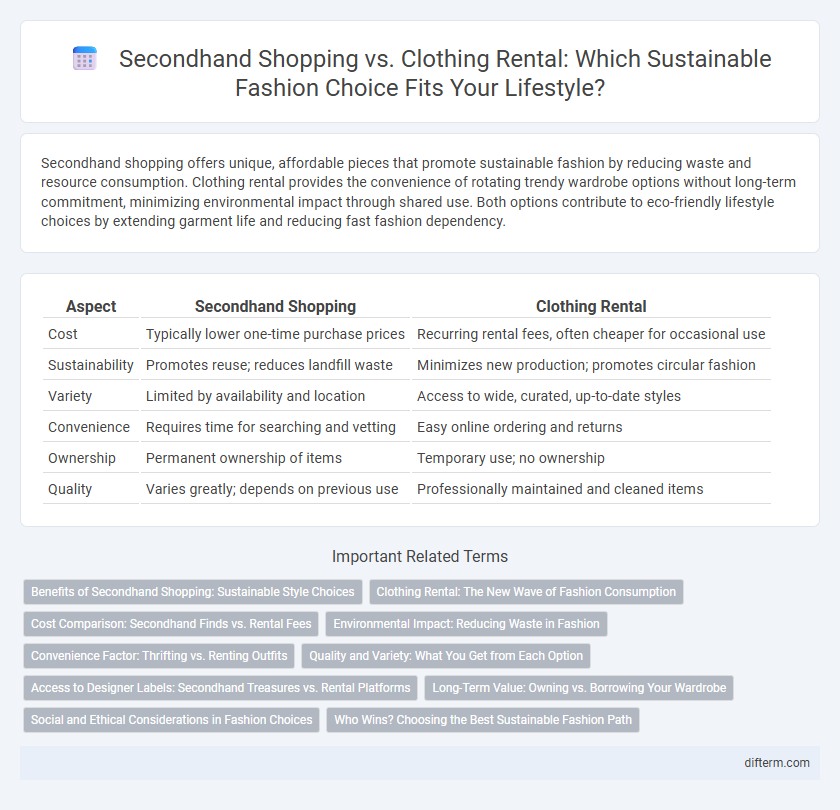Secondhand shopping offers unique, affordable pieces that promote sustainable fashion by reducing waste and resource consumption. Clothing rental provides the convenience of rotating trendy wardrobe options without long-term commitment, minimizing environmental impact through shared use. Both options contribute to eco-friendly lifestyle choices by extending garment life and reducing fast fashion dependency.
Table of Comparison
| Aspect | Secondhand Shopping | Clothing Rental |
|---|---|---|
| Cost | Typically lower one-time purchase prices | Recurring rental fees, often cheaper for occasional use |
| Sustainability | Promotes reuse; reduces landfill waste | Minimizes new production; promotes circular fashion |
| Variety | Limited by availability and location | Access to wide, curated, up-to-date styles |
| Convenience | Requires time for searching and vetting | Easy online ordering and returns |
| Ownership | Permanent ownership of items | Temporary use; no ownership |
| Quality | Varies greatly; depends on previous use | Professionally maintained and cleaned items |
Benefits of Secondhand Shopping: Sustainable Style Choices
Secondhand shopping reduces textile waste by extending the life cycle of garments, making it a highly sustainable style choice in the fashion industry. It offers unique, vintage pieces that support circular fashion and decrease the demand for new clothing production, thereby lowering carbon emissions. Embracing secondhand clothing fosters environmental responsibility while providing affordable, diverse wardrobe options.
Clothing Rental: The New Wave of Fashion Consumption
Clothing rental revolutionizes fashion consumption by offering sustainable and affordable alternatives to fast fashion, reducing textile waste and carbon footprints significantly. This model allows consumers to access high-quality, designer clothing for special occasions or everyday style without the commitment of ownership. Rapid growth in digital rental platforms reflects increasing demand for eco-conscious and cost-effective wardrobe options in the evolving lifestyle landscape.
Cost Comparison: Secondhand Finds vs. Rental Fees
Secondhand shopping offers a one-time purchase cost often significantly lower than the cumulative rental fees of clothing rental services, making it a budget-friendly option for sustainable fashion. While rental fees can add up quickly, especially for frequent use or multiple items, secondhand finds provide ownership without recurring expenses. Buyers should consider the long-term financial impact, as investing in secondhand pieces can lead to greater savings compared to ongoing rental costs.
Environmental Impact: Reducing Waste in Fashion
Secondhand shopping significantly reduces environmental impact by extending the lifespan of garments, preventing textile waste from reaching landfills. Clothing rental further minimizes waste by promoting a shared economy where fewer new clothes are produced, lowering resource consumption and carbon emissions. Both practices contribute to sustainable fashion by decreasing the demand for fast fashion and reducing overall textile pollution.
Convenience Factor: Thrifting vs. Renting Outfits
Secondhand shopping offers the convenience of immediate ownership, allowing shoppers to browse at their own pace without return deadlines. Clothing rental provides a hassle-free way to access high-end, trendy outfits for special occasions without the commitment of purchase or long-term storage. Both options reduce environmental impact, but rentals emphasize ease of outfit variety while thrifting appeals to those prioritizing budget-friendly, one-time acquisitions.
Quality and Variety: What You Get from Each Option
Secondhand shopping offers a diverse variety of high-quality, vintage, and unique clothing items rooted in different eras and styles, appealing to those seeking individuality and sustainability. Clothing rental provides access to premium, trendy, and often designer pieces in excellent condition, ideal for special occasions or short-term use while minimizing wardrobe clutter. Both options promote eco-friendly fashion choices by extending the lifecycle of garments, though secondhand shopping emphasizes variety and permanence, whereas rentals focus on temporary quality and exclusivity.
Access to Designer Labels: Secondhand Treasures vs. Rental Platforms
Access to designer labels through secondhand shopping offers unique, one-of-a-kind treasures often unavailable in rental platforms, allowing consumers to own exclusive pieces at varied price points. Clothing rental services provide a curated selection of high-end brands, enabling frequent wardrobe rotation without commitment, though availability may be limited by inventory constraints. Both options democratize luxury fashion, catering to sustainability-conscious shoppers seeking designer styles with different ownership experiences.
Long-Term Value: Owning vs. Borrowing Your Wardrobe
Secondhand shopping offers long-term value through ownership, allowing individuals to build a unique, sustainable wardrobe with timeless pieces that can be worn repeatedly. Clothing rental provides flexibility and variety by enabling users to access high-end fashion without the commitment of ownership, reducing consumption and waste. Both options promote eco-friendly choices, but secondhand purchases create lasting value by integrating items permanently into one's lifestyle, while rentals emphasize short-term use and experimentation.
Social and Ethical Considerations in Fashion Choices
Secondhand shopping reduces fashion waste by extending garment lifecycles, promoting sustainable consumption and lowering environmental impact. Clothing rental offers access to high-quality fashion without ownership, challenging fast fashion's ethical concerns related to labor exploitation and resource depletion. Both methods foster conscious consumerism and support ethical practices by addressing the environmental and social issues inherent in traditional fashion production.
Who Wins? Choosing the Best Sustainable Fashion Path
Secondhand shopping reduces fashion waste by extending the life of garments, offering affordability and unique style, while clothing rental minimizes production demand through temporary use of high-quality pieces. Environmental impact studies show secondhand shopping typically results in lower carbon emissions and water usage compared to repeated garment production for rental cycles. Consumers seeking long-term sustainability and budget-friendly options often favor secondhand; those prioritizing variety and occasional wear find clothing rental advantageous.
Secondhand shopping vs Clothing rental Infographic

 difterm.com
difterm.com